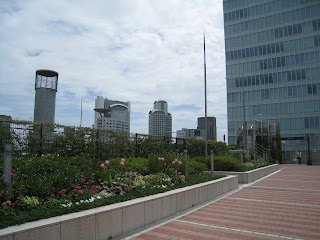Kyoto is many things: magnificently large, magnificently crowded, magnificently hot, magnificently humid. And magnificently skyscrapered.
Especially centered around the many-lobed shopping mall/hotel/William-Gibson-novel-city connected to the Kyoto train station, the skyscrapers are numerous. I think they may be infinite, spawning by running stolons along, just under the sidewalk.The boundary between interior and exterior is in some places sharply defined, with solid mirrored slabs, and elsewhere porous, with open enclosed spaces and revolving doors in sequences of airlocks to keep the air conditioning inside and the oppressive heat outside.
It is possible to climb up to the roof of several skyscrapers.
I did this to give myself some goals whose intermediate steps all involved staying indoors, in climate control, shielded from the oppressive day-star.
But the roofs were dramatic. It's a view that cannot be had from the hot, humid, crowded ground, where other humans, and trains, and buses, and the buildings themselves, prevent a wider survey of the city.
This roof had a community garden, a touch which was quaint and adorable. The garden must be visited by millions of tourists a year (taking exactly the photos I took), but was completely unmolested. The signs requesting that we not stand in the flower beds (to take better photos) were, miraculously, respected: this is Japan. It's hot and humid, and rice paddies are visible between low-slung residential buildings, but somehow it is still an enormous urban center.
Fun.
This post's theme word is purlieu, "a neighboring area," or "a place that one frequents or has control." The skyscrapers' purlieu featured gardens, castles, and (mostly) other skyscrapers.







